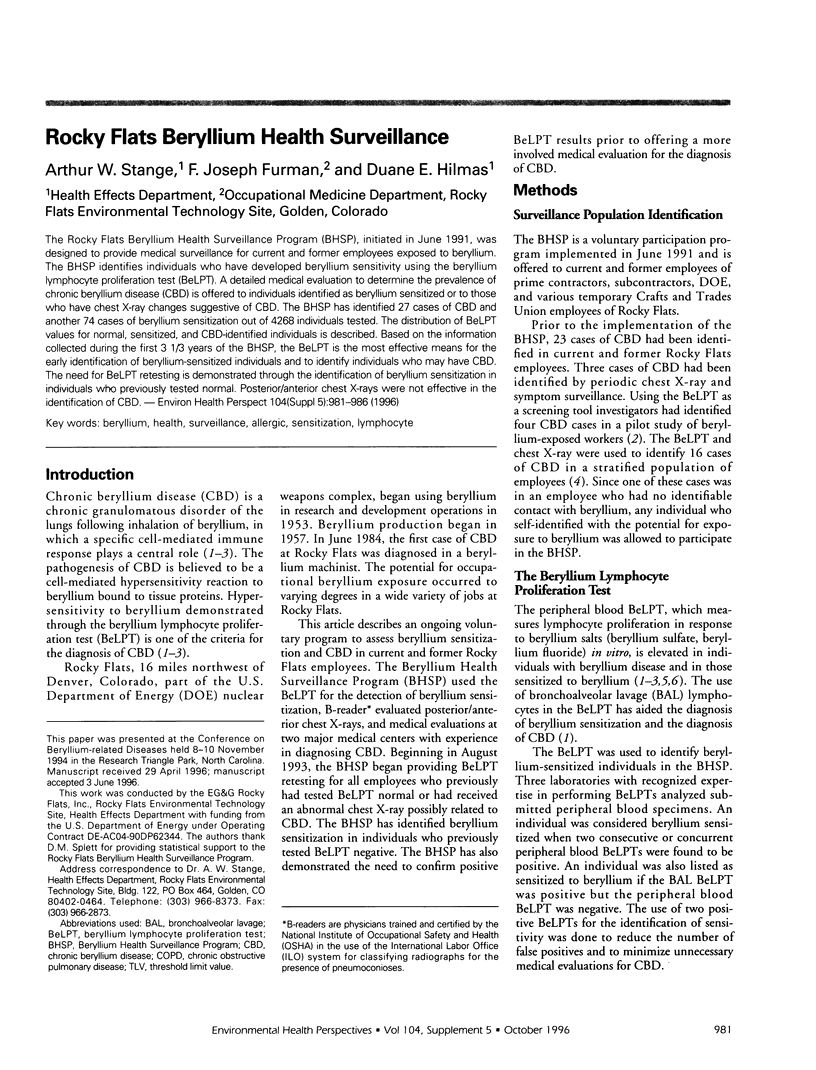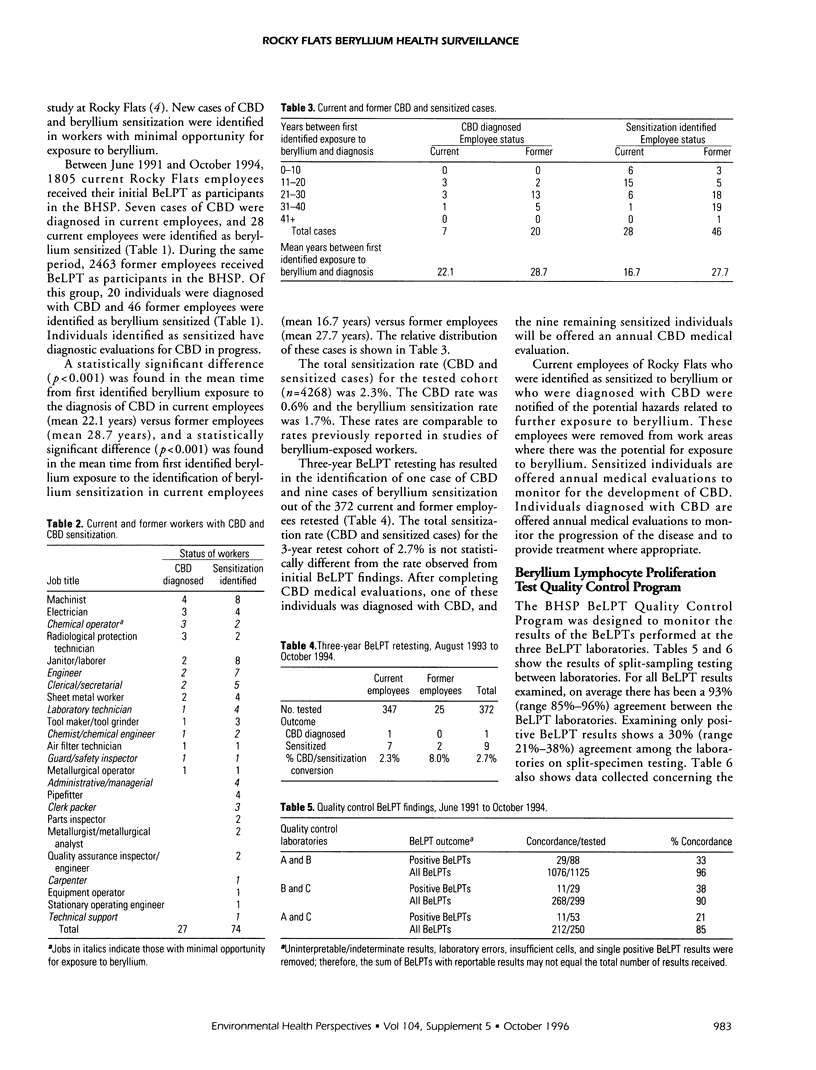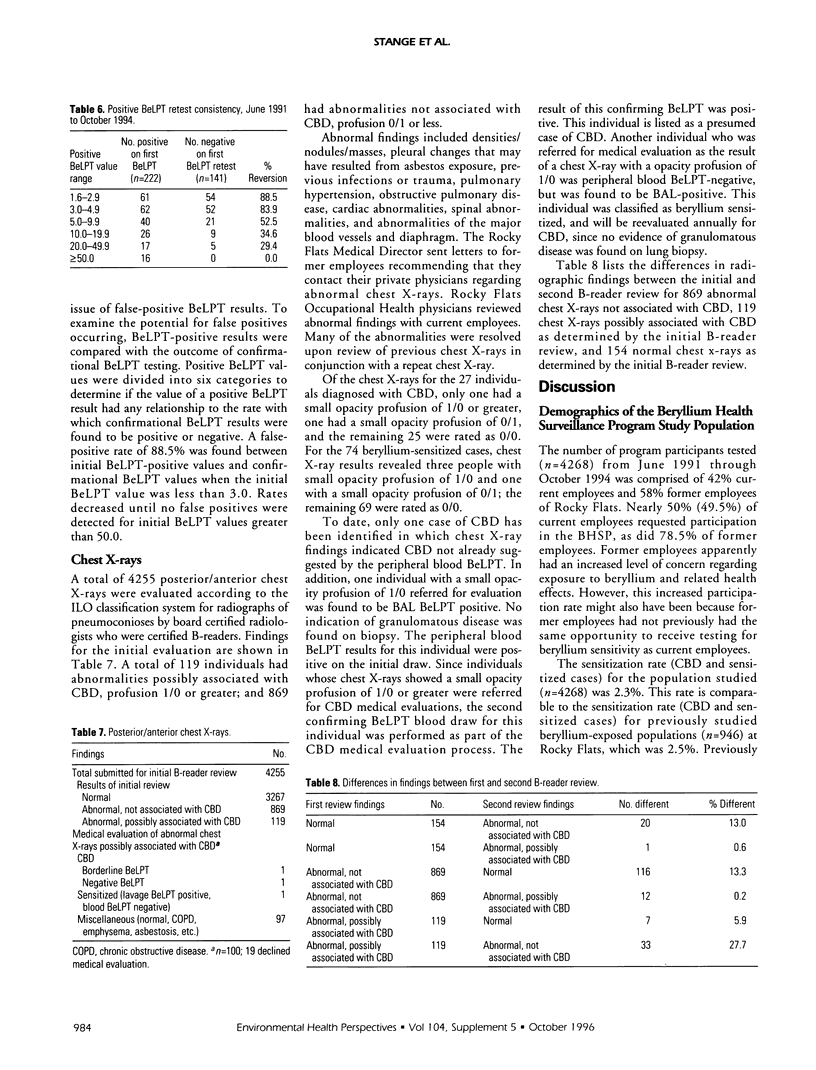Abstract
The Rocky Flats Beryllium Health Surveillance Program (BHSP), initiated in June 1991, was designed to provide medical surveillance for current and former employees exposed to beryllium. The BHSP identifies individuals who have developed beryllium sensitivity using the beryllium lymphocyte proliferation test (BeLPT). A detailed medical evaluation to determine the prevalence of chronic beryllium disease (CBD) is offered to individuals identified as beryllium sensitized or to those who have chest X-ray changes suggestive of CBD. The BHSP has identified 27 cases of CBD and another 74 cases of beryllium sensitization out of 4268 individuals tested. The distribution of BeLPT values for normal, sensitized, and CBD-identified individuals is described. Based on the information collected during the first 3 1/3 years of the BHSP, the BeLPT is the most effective means for the early identification of beryllium-sensitized individuals and to identify individuals who may have CBD. The need for BeLPT retesting is demonstrated through the identification of beryllium sensitization in individuals who previously tested normal. Posterior/anterior chest X-rays were not effective in the identification of CBD.
Full text
PDF





Selected References
These references are in PubMed. This may not be the complete list of references from this article.
- Deodhar S. D., Barna B., Van Ordstrand H. S. A study of the immunologic aspects of chronic berylliosis. Chest. 1973 Mar;63(3):309–313. doi: 10.1378/chest.63.3.309. [DOI] [PubMed] [Google Scholar]
- FAY J. W., ASHFORD J. R. The study of observer variation in the radiological classification of pneumoconiosis. Br J Ind Med. 1960 Oct;17:279–292. doi: 10.1136/oem.17.4.279. [DOI] [PMC free article] [PubMed] [Google Scholar]
- Hanifin J. M., Epstein W. L., Cline M. J. In vitro studies on granulomatous hypersensitivity to beryllium. J Invest Dermatol. 1970 Oct;55(4):284–288. doi: 10.1111/1523-1747.ep12260036. [DOI] [PubMed] [Google Scholar]
- Kreiss K., Miller F., Newman L. S., Ojo-Amaize E. A., Rossman M. D., Saltini C. Chronic beryllium disease--from the workplace to cellular immunology, molecular immunogenetics, and back. Clin Immunol Immunopathol. 1994 May;71(2):123–129. doi: 10.1006/clin.1994.1061. [DOI] [PubMed] [Google Scholar]
- Kreiss K., Mroz M. M., Zhen B., Martyny J. W., Newman L. S. Epidemiology of beryllium sensitization and disease in nuclear workers. Am Rev Respir Dis. 1993 Oct;148(4 Pt 1):985–991. doi: 10.1164/ajrccm/148.4_Pt_1.985. [DOI] [PubMed] [Google Scholar]
- Kreiss K., Newman L. S., Mroz M. M., Campbell P. A. Screening blood test identifies subclinical beryllium disease. J Occup Med. 1989 Jul;31(7):603–608. doi: 10.1097/00043764-198907000-00011. [DOI] [PubMed] [Google Scholar]
- Pappas G. P., Newman L. S. Early pulmonary physiologic abnormalities in beryllium disease. Am Rev Respir Dis. 1993 Sep;148(3):661–666. doi: 10.1164/ajrccm/148.3.661. [DOI] [PubMed] [Google Scholar]
- Richeldi L., Sorrentino R., Saltini C. HLA-DPB1 glutamate 69: a genetic marker of beryllium disease. Science. 1993 Oct 8;262(5131):242–244. doi: 10.1126/science.8105536. [DOI] [PubMed] [Google Scholar]
- Rossman M. D., Kern J. A., Elias J. A., Cullen M. R., Epstein P. E., Preuss O. P., Markham T. N., Daniele R. P. Proliferative response of bronchoalveolar lymphocytes to beryllium. A test for chronic beryllium disease. Ann Intern Med. 1988 May;108(5):687–693. doi: 10.7326/0003-4819-108-5-687. [DOI] [PubMed] [Google Scholar]
- Williams W. J., Williams W. R. Value of beryllium lymphocyte transformation tests in chronic beryllium disease and in potentially exposed workers. Thorax. 1983 Jan;38(1):41–44. doi: 10.1136/thx.38.1.41. [DOI] [PMC free article] [PubMed] [Google Scholar]


